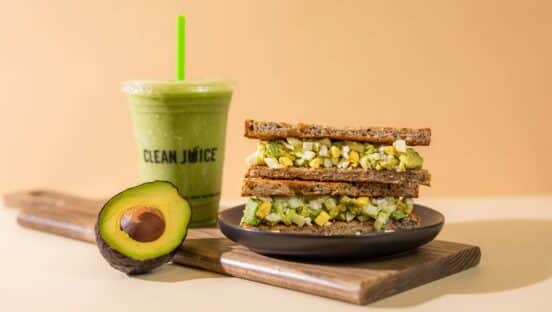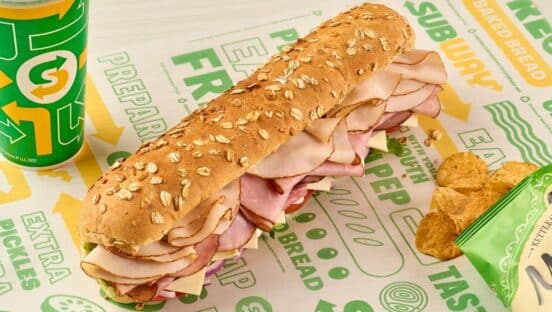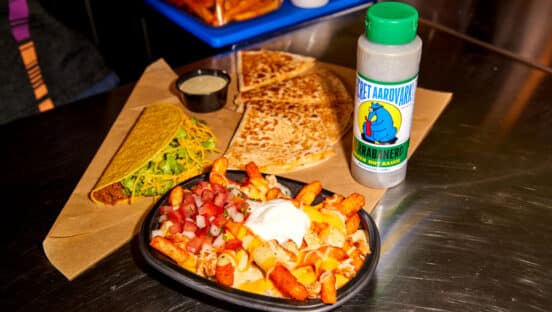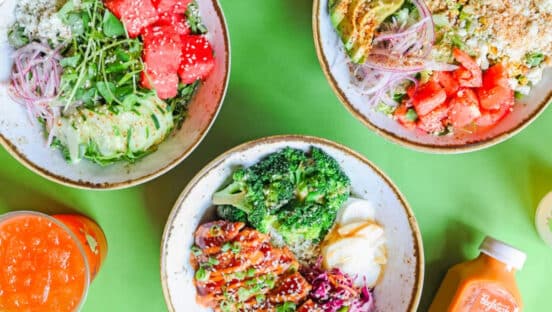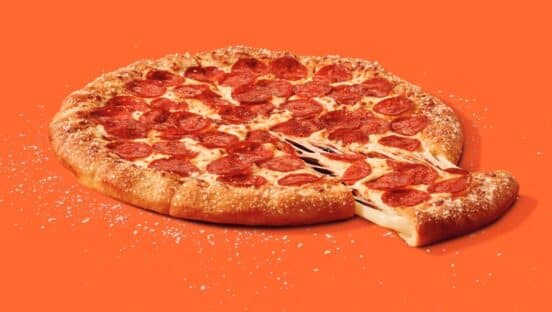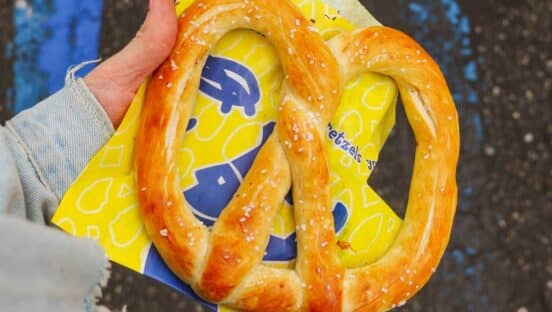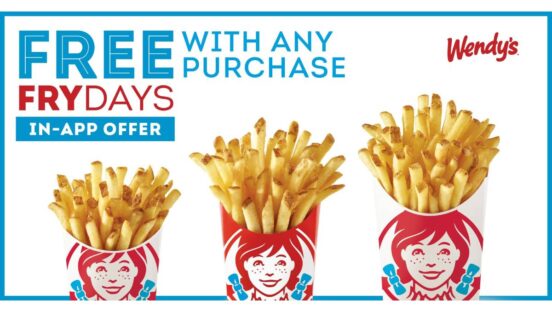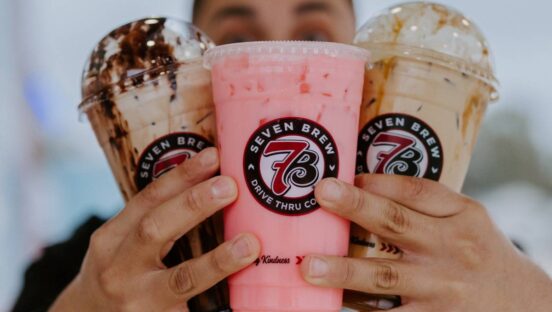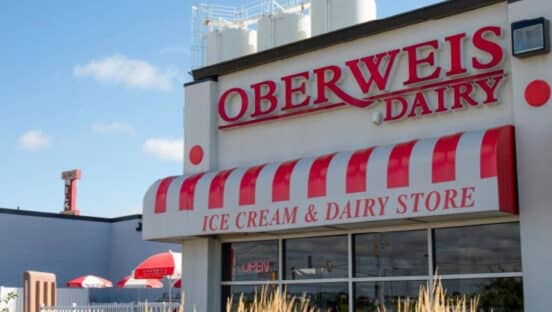At what you might call the COVID-19 bottom for Yum! Brands, the company had 11,000 restaurants closed globally. That’s slimmed to 10,000 as the company gets “back into the business of reopening,” CEO David Gibbs said Wednesday. On March 24, Yum! pegged the number at 7,000.
In the first week of March, global same-store sales reported flat for the KFC, Taco Bell, Pizza Hut, and now, Habit Grill, owner. Figures rapidly dropped the following week to negative 10 percent. Over the second half of March and into April, comps fell 30 percent on average, including the impact of nearly 20 percent of Yum!’s massive 50,000-unit system shutting down.
Pizza Hut’s global same-store sales in that window decreased 20–25 percent. Taco Bell dropped 30 percent and KFC slipped 35 percent, anchored by the shuttering of more than 20 percent of its 24,304-unit fleet. By that math, roughly 4,660 of Yum!’s 10,000 closures were KFC restaurants.
Gibbs did not provide specifics about more recent results, only to say “trends have improved significantly as we’ve moved through April,” and the company is reopening more restaurants “every day,” highlighted by 100 next week in the U.K.
READ MORE:
The Habit pivots at warp speed
STAY UP TO DATE WITH OUR CORONAVIRUS LANDING PAGE
In Q1, which ended March 31, KFC’s same-store sales plunged 8 percent, including 9 percent internationally, where it counts 20,260 restaurants, and 3 percent domestic. Pizza Hut witnessed an 11 percent same-store sales drop (negative 7 percent in the U.S. and negative 14 percent international). Taco Bell was on its way to a 6 percent gains before COVID-19 sent it to a slight 1 percent systemwide lift, lapping 4 percent growth in the year-ago period.
As a company, Yum!’s Q1 net income came in at $83 million, or 27 cents per share, down from $262 million, or 83 cents per share, last year. Revenue totaled $1.26 billion. Core operating profit decreased 6 percent.
The challenges were not universal for Yum!, as each brand grappled with its own COVID-19 setbacks. Taco Bell, in particular, had to adjust to two major shifts in customer behavior.
The brand diverted ad spend to off-premises programs and started offering free delivery on orders over $12 through Grubhub. In the U.S., pre-COVID-19, delivery and drive-thru sales represented about 75 percent of sales at Taco Bell. Now, it’s close to 100 percent, Gibbs said. And 10 percent of that is flowing through digital.
Gibbs added Taco Bell managed to maintain its below 4-minute drive-thru times while hitting all-time lows in customer dissatisfaction. “This is remarkable, considering how quickly the landscape has changed,” Gibbs said. And proof people have appreciated the break in quarantine routines.
Yum! gave Taco Bell operators the option to pause breakfast in late March and adjust hours of operation as their market conditions see fit.
So all that noted, why was Taco Bell’s peak declines between KFC and Pizza Hut (at negative 30 percent) and not system fronting?
It’s nothing complicated, Gibbs said, and returns to two big changes brought on by stay-at-home directives. Taco Bell’s business, unlike Yum! peers, features a strong breakfast component (roughly 10 percent of mix). Morning sales have softened significantly across the industry in light of fewer people driving to work. The other side of this is late-night—another Taco Bell fixture. That’s been “obviously impacted,” Gibbs said, “as people aren’t out in bars and theaters and things like that.”
TACO BELL EXEC: WE WANT TO BECOME THE SAFEST PLACE TO EAT
Yet Taco Bell’s heavy drive-thru focus and marketing efforts countered the hurdles and have gained momentum in April. In Q4, Yum! said the brand lifted its comparable speed of service 20 seconds over the course of the year, which translated to 9 million more cars rolling through the drive thru in 2019.
In the U.S., 95 percent of Taco Bell and KFC locations have drive thrus. “…we are made for contactless,” Gibbs said.
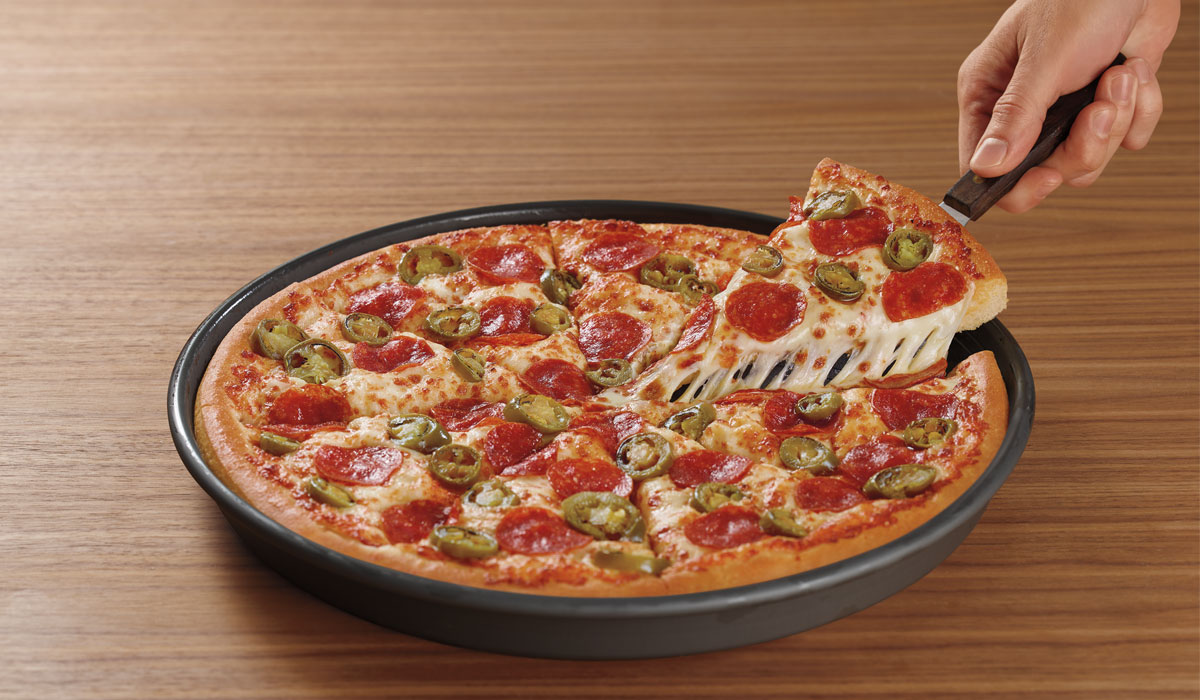
By the brand, more operators, employee care
As part of its COVID-19 pivot, Yum! brought contactless services to 90 percent of KFC’s markets. If current trends sustain, Gibbs said, KFC globally could end 2020 with more than a quarter of its sales flowing through digital channels.
In the U.S., the chain focused on family style meals, like a $30 Fill Up that adds 12 tenders to the $20 construct.
Gibbs said digital sales jumped to about 10 percent of orders stateside, up from low-single digits just a month ago. And importantly, for margins sake, 40 percent of that business is going direct through KFC.com, which launched late 2019.
Pizza Hut continues to undergo a mass message shift since COVID-19. In some ways, it aligns with what the company was already trying to accomplish—it’s just squeezed years of initiatives into weeks. The focus, to date, has primarily centered on contactless service, food safety, employee care, and giving back, Gibbs said.
Pizza Hut’s U.S. system spent much of Q1 shifting toward more targeted and high-margin value deals and core products, while offering limited-time promotional value on premium products, like a Specialty Meat Lover’s Pizza and Big Dipper.
The major challenge for Pizza Hut, though, remains on the real-estate level as it pushes toward an asset light, carryout and delivery focused fleet.
The chain shuttered 137 domestic restaurants in Q1 to finish the period with 7,198 U.S. restaurants.
Here’s how that has tracked as the company tries to move away from its dine-in past:
Q1 2020:
- Closures: 137
- New builds: 29
- Total retraction: 108
- Total: 7,198
2019
Q4:
- Closures: 136
- New builds: 52
- Total retraction: 84
- Total: 7,306
Q3:
- Closures: 98
- New builds: 39
- Total retraction: 59
- Total: 7,390
Q2:
- Closures: 71
- New builds: 47
- Total retraction: 24
- Total: 7,449
Q1:
- Closures: 56
- New builds: 47
- Total retraction: 9
- Total: 7,473
Gibbs said Pizza Hut now offers carryout and curbside pick-up in more than 90 countries. Its recent off-premises gains helped offset the impact of closed dining rooms, as well as the vast majority of its Express units, which represented 5 percent of overall system sales in 2019. Yum! said earlier roughly 1,000 Express stores were dark due to COVID-19.
Historically, 50 percent of Pizza Hut’s international sales come outside the four walls. That’s bumped to 70 percent recently.
Gibbs said the company set a digital sales record recently, selling more orders on a random Friday than in each of the last two Super Bowls.
“It gives you a sense that the brand is going through some rapid changes, things that have been on our roadmap,” he said. “… This three-month period we’re in right now is basically going to have three years’ worth of changes to our business. “It’s accelerating the plan that we had for Pizza Hut in getting us to be this truly digital, delivery, carryout business.”
Yum! is 98 percent franchised. But at its 1,200 corporate locations, the company had paid scheduled hours to employees required to stay home due to COVID-19. It’s also provided $1,000 one-time bonuses to GMs and committed to pay Q2 bonuses, despite the fact restaurant sales wouldn’t normally qualify.
In June, Yum! also plans to provide one-time bonuses to the majority of store-level workers. Gibbs said franchisees, “are also taking steps to increase support of restaurant team members during this critical time.” Additionally, Yum! created a global employee medical relief fund to offer financial support to employees diagnosed with COVID-19, or caring for someone with the virus, at the corporate and franchised level.
For operators, Yum! is offering grace periods for certain near-term payments and deferring select asset obligations. These grace periods provide franchisees with cash-flow constraints an additional 60 days to pay two of their royalty payments. Yum! deferred 2020 capital obligations for remodels and new development up to a year in the U.S. and in select international markets.
The company implemented a hiring freeze and Gibbs decided to forgo his salary. Yum! also eliminated most travel and in-person meetings until at least September.
CFO Chris Turner brought up another possible change Wednesday, saying the company was “fielding some inbound requests from outside capital partners who would like to put money to work in our system.”
“It starts with the primary focus of working with our existing franchisees, in particular, those who are suffering the most distress, but we do have backup plans with partners who could step in if needed in certain parts of the globe,” he said.
Yum! has addressed “bad debt expense” in recent quarters, mainly as it pertains to Pizza Hut’s U.S. system. In Q4, bad debt expense related to royalties and digital fees was $8 million for Pizza Hut’s global division, up $4 million year-over-year. For the full year, it was $22 million, an increase of $12 million.
Yum! credited “just a handful of franchisee situations,” and has spoken at length about some overleveraged operators in its system who might need to exit. Or, possibly, sell their restaurants to other parties—an outlet amplified by crisis conditions.
This past quarter, Yum! said bed debt expense from franchisees reached $28.5 billion, up about $22 million year-over-year. It continues “to be a story of a small number of accounts,” Turner said.
He said COVID-19 caused about $5.5 million of the figure. The other $17 million was tied to “franchisee specific situations” primarily driven by a few KFC accounts, mostly in Europe and Latin America, and a handful of Pizza Hut U.S. operators. Turner said eight Pizza Hut U.S. operators are driving 80 to 90 percent of the balance. Bloomberg reported in February Pizza Hut’s largest U.S. franchisee with 1,2000 units, NPC International, was weighing bankruptcy after defaulting on about $800 million of debt after it elected to skip loan payments.


